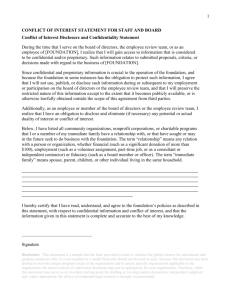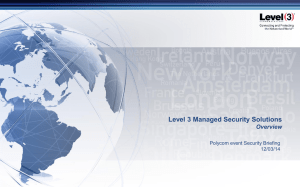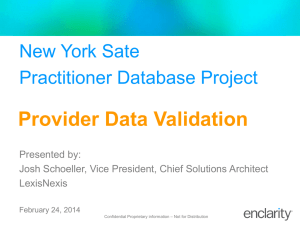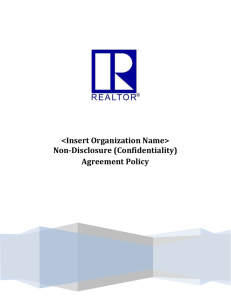Parney Albright - The Security Network
advertisement
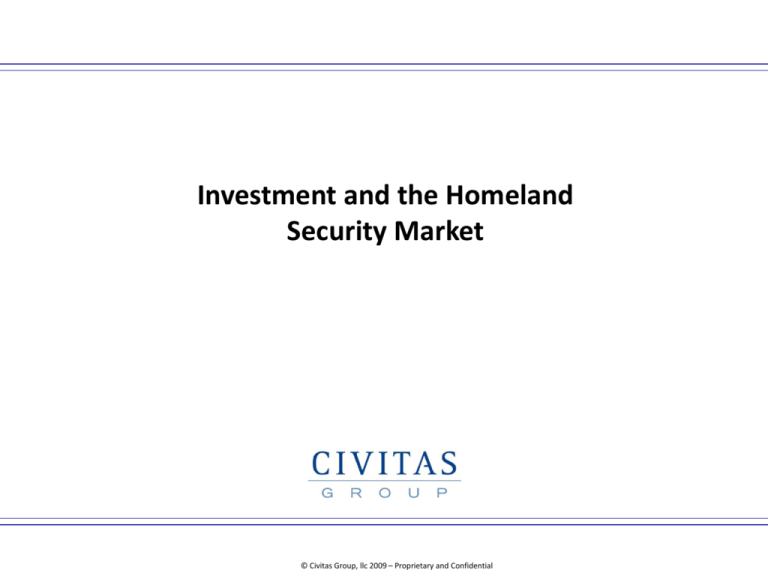
Investment and the Homeland Security Market © Civitas Group, llc 2009 – Proprietary and Confidential Outline The Investor's View of the Market Market Imperatives—the Firm’s Approach Summary 2 © Civitas Group, llc 2009 – Proprietary and Confidential VIEW OF THE MARKET 3 © Civitas Group, llc 2009 – Proprietary and Confidential HLS Market View (1 of 3) The Homeland Security Market is large and growing • The market, in aggregate, represents annual spending of (2009) $113 billion that is addressable by the private sector. • Government security funding expected to remain on positive slope – The threat is persistent and dangerous – The markets for the Chemical, Biological, Radiological, and Nuclear Threats (CBRN); Cyber Security; and Border Security mission areas represent significant growth areas due to several high-profile, well-funded initiatives at the Federal level. – But—growth rates slowing in the Obama Administration ~7% CAGR ~2% CAGR • Commercial spending is increasing as new solutions become available, regulatory environment clarifies, and risk/threat remains substantial – For example, better explosive detection systems are available; better radiation detectors; etc – Desire to head off regulatory action, e.g., chemical plants, cargo security • International market is growing; threat driven – Spain, India, UK plots – But concerns are different—outside US & UK, little worry about nukes, for example, or bio 4 © Civitas Group, llc 2009 – Proprietary and Confidential HLS Market View (2 of 3) Federal government policy is central • Through regulation, RDT&E, and programs, the risks are de facto prioritized • Demand can be created through legislation & regulation – E.g. requirements for cargo screening; aviation security; background checks for bio researchers Technology driven market • Current technology generally insufficient to meet mission/market demands – Chem detectors have too many false alarms – Airport passenger checkpoints not really designed for explosive detection – Counter MANPAD system Mean Time to Failure=300 hrs • Priorities on improved performance, lower cost of ownership and ease of operation – ARFCAM program for chem (with a cost bogey of $2K ea and turnkey operations) – $300M+ counterMANPAD program focused almost solely on increasing MTTF to 3000 hrs 5 © Civitas Group, llc 2009 – Proprietary and Confidential HLS Market View (3 of 3) Market is diverse and fragmented • Government market and policymaking is much more than DHS (e.g., HHS, DOD, intel) • Customers include all levels of government, and commercial entities – >30,000 police departments, >10,000 fire departments Competition/market leadership still evolving • Traditional DOD primes vs. commercial providers • No clear dominant players 6 © Civitas Group, llc 2009 – Proprietary and Confidential Market Size by Buyer Significant fractions of the Homeland Security Market are not in the Federal space. Although the Federal government captures roughly one third of the market, Federal policy is a strong driver for all other parts of the market. Total Addressable Homeland Security Market (in $ Billions, per year) $52 US Domestic ($61B/yr) $4 International $113 Private Sector $11 State, Local, and Quasi Gov’t $46 Total Market Federal 7 © Civitas Group, llc 2009 – Proprietary and Confidential Market Size by Mission Area The estimated size of the Homeland Security Market is $113 Billion per year, with Cyber Security, Critical Infrastructure Protection, CIP, and Border Security representing the largest mission areas. The U.S. portion of this market represents about $60 Billion of addressable spending that may be captured by the private sector. FY 2009 U.S. Addressable Market, by Mission Area (total market = $60B) Cyber Security 27% CBRN 10% Border Security 16% Emergency Prep & Response 13% Critical Infrastructure Protection (CIP) 22% Intelligence/ Domestic CT 5% Policy Priorities CIP - Transportation 7% Counter CBRN Border security Critical infrastructure protection Cybersecurity Emergency Preparedness & Response 8 © Civitas Group, llc 2009 – Proprietary and Confidential Market Attractiveness by Mission Area The attractiveness of each market segment is a reflection of how much the segment can be expected to grow, and how much of the market is potentially accessible. Only a certain percentage of the addressable market will actually be accessible at any given time – the remainder will have already been captured as part of ongoing programs. Border Security, Cyber Security, and CBRN show the greatest growth potential (>2.5%), while Cyber, CIP (including Transportation) and Border Security have the most new contract opportunities (as a percentage of the market size). 20% Border Security Growth Rate 15% Cyber Security 10% CBRN Critical Infrastructure Protection (CIP) Intelligence/ Domestic CT 5% Emergency Prep & Response 0% 0% 10% 20% CIP - Transportation 30% 40% -5% *Based on snapshot of current & anticipated contracts for FY09 9 % Accessible* © Civitas Group, llc 2009 – Proprietary and Confidential 50% 60% MARKET IMPERATIVES—WHAT FIRMS NEED TO BE THINKING 10 © Civitas Group, llc 2009 – Proprietary and Confidential Market Imperatives I Buyers (and investors) want a demonstrated capability • Vugraphs need not apply, and lab tests are marginally better Buyers Want Solutions not Widgets • HLS government (and commercial) buyers lack the capability for turning a problem into a system concept, performance specification and program plan • Tend to be suspicious of technology • This places a premium on the ability to integrate technologies into a solution – Operations have to be turnkey—there are no tech training schools, and no combat support equivalents • Absolute need to understand operational and policy constraints—requires investment Buyers Emphasize Total Cost of Ownership • Cost really is an independent variable – Local jurisdictions and federal agencies like the Border Patrol cannot afford major and enduring increases in operational costs • Training, logistics, maintenance, consumables—in HLS, cannot afford depots, dedicated support, specialized operators State and local marketplace is structurally flawed • Need a plausible story for how you will scale to National-scale revenue 11 © Civitas Group, llc 2009 – Proprietary and Confidential Market Imperatives II Don’t bring a “DoD” solution—it will rarely apply • Performance; suitability; cost; secrecy—But core technology can transfer Opportunities Can Be Shaped—what is the plan? • Ideas marketplace—absence of systems engineering and requirements generation culture allows providers of good ideas a hearing and an opportunity • “Build it and they will come” approaches will fail • Firm needs to focus on channel development and seek strategic investors Research and development participation important • Most DHS/S&Tprograms became procurements (e.g. ASP) • New leadership likely to reinvigorate SAFETY Act and liability relief • Confers derivative protections onto buyers—significant discriminator 12 © Civitas Group, llc 2009 – Proprietary and Confidential Summary Investors want significant returns • Will look for priority markets with both revenue and growth • Will be very leary of programs that can’t plausibly argue a means toward “National” scales Investors expect the firm to understand the buyer • Operational environment and constraints • Cost effectiveness With that being said… • Attractive market to savvy investors • Lots of funding and room for growth • Technology-driven — new, good ideas can prevail 13 © Civitas Group, llc 2009 – Proprietary and Confidential
